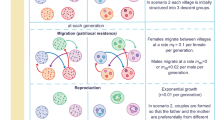Abstract
In female mammals, fertility declines abruptly at an advanced age. The human menopause is one example, but reproductive cessation has also been documented in non-human primates, rodents, whales, dogs, rabbits, elephants and domestic livestock1,2,3. The human menopause has been considered an evolutionary adaptation4,5,6,7 assuming that elderly women avoid the increasing complications of continued childbirth to better nurture their current children and grandchildren. But an abrupt reproductive decline might be only a non-adaptive by-product of life-history patterns. Because so many individuals die from starvation, disease and predation, detrimental genetic traits can persist (or even be favoured) as long as their deleterious effects are delayed until an advanced age is reached, and, for a given pattern of mortality, there should be an age by which selection would be too weak to prevent the onset of reproductive senescence4,5,8. We provide a systematic test of these alternatives using field data from two species in which grandmothers frequently engage in kin-directed behaviour. Both species show abrupt age-specific changes in reproductive performance that are characteristic of menopause. But elderly females do not suffer increased mortality costs of reproduction, nor do post-reproductive females enhance the fitness of grandchildren or older children. Instead, reproductive cessation appears to result from senescence.
This is a preview of subscription content, access via your institution
Access options
Subscribe to this journal
Receive 51 print issues and online access
$199.00 per year
only $3.90 per issue
Buy this article
- Purchase on Springer Link
- Instant access to full article PDF
Prices may be subject to local taxes which are calculated during checkout






Similar content being viewed by others
References
vom Saal, F. S., Finch, C. E. & Nelson, J. F. in The Physiology of Reproduction 2nd edn (eds Knobil, E. & Neill, J. D.) 1213–1314 (Raven, New York, 1994).
Finch, C. E. Longevity, Senescence and the Genome (Univ. Chicago Press, 1990).
Laws, R. M., Parker, I. S. C. & Johnstone, R. C. B. Elephants and their Habitats (Clarendon, Oxford, 1975).
Williams, G. C. Pleiotropy, natural selection, and the evolution of senescence. Evolution 11, 398–411 (1957).
Hamilton, W. D. The moulding of senescence by natural selection. J. Theor. Biol. 12, 12–45 (1966).
Hawkes, K., O'Connell, J. F. & Blurton-Jones, N. Hadza women's time allocation, offspring provisioning, and the evolution of long postmenopausal life spans. Curr. Anthropol. 38, 551–565 (1997).
Rogers, A. R. Why menopause? Evol. Ecol. 7, 406–420 (1993).
Charlesworth, B. Evolution in Age-structured Populations (Cambridge Univ. Press, Cambridge, 1980).
van Noord, P. A. H., Dubas, J. S., Dorland, M., Boersma, H. & te Velde, E. Age at natural menopause in a population-based screening cohort: the role of menarche, fecundity, and lifestyle factors. Fertil. Steril. 68, 95–102 (1997).
Gouzoules, S. & Gouzoules, H. in Primate Societies (eds Smuts, B. B. et al.) 299–305 (Univ. Chicago Press, 1987).
Packer, C., Scheel, D. & Pusey, A. E. Why lions form groups: food is not enough. Am. Nat. 136, 1–19 (1990).
McComb, K., Packer, C. & Pusey, A. E. Roaring and numerical assessment in contests between groups of female lions, Panthera leo. Anim. Behav. 47, 379–387.
Heinsohn, R. & Packer, C. Complex cooperative strategies in group-territorial African lions. Science 269, 1260–1262 (1995).
Pusey, A. E. & Packer, C. Non-offspring nursing in social carnivores: minimizing the costs. Behav. Ecol. 5, 362–374 (1994).
Reznick, D. Costs of reproduction: an evaluation of the empirical evidence. Oikos 44, 257–267 (1985).
Vaupel, J. W. & Iashin, A. I. Heterogeneity's ruses: some surprising effects of selection on population dynamics. Am. Stat. 39, 177–185 (1985).
Medawar, P. B. The Uniqueness of the Individual (Dover, New York, 1952).
Caswell, H. Matrix Population Models (Sinauer, Sunderland, MA, 1989).
Wise, P. M., Krajnak, K. M. & Kashon, M. L. Menopause: The aging of multiple pacemakers. Science 273, 67–70 (1996).
Stolwijk, A. M., Zielhuis, G. A., Sauer, M. V., Hamilton, C. J. C. M. & Paulson, R. J. The impact of the woman's age on the success of standard and donor in vitro fertilization. Fertil. Steril. 67, 702–710 (1997).
Hill, K. & Hurtado, A. M. The evolution of premature reproductive senescence and menopause in human females: an evaluation of the “Grandmother Hypothesis.” Hum. Nature 2, 313–350 (1991).
Packer, C. et al. Reproductive constraints on aggressive competition in female baboons. Nature 373, 60–63 (1995).
Packer, C. & Pusey, A. E. The Lack clutch in a communal breeder: lion litter size is a mixed evolutionarily stable strategy. Am. Nat. 145, 833–841 (1995).
Altmann, S. A. The pregnancy sign in savannah baboons. Lab. Anim. Digest 6, 7–10 (1970).
Lee, E. T. Statistical Methods for Survival Data Analysis,2nd edn (J. Wiley, New York, 1992).
Acknowledgements
We thank E. C. Birney, M. Borgerhoff Mulder, E. L. Charnov, C. E. Finch, K. Hawkes, P. A. Hunt, M. McClintock, D. Promislow, A. R. Rogers, F. S. vom Saal and P. M. Wise for comments and discussion. Fieldwork on the baboons was supported by the Jane Goodall Institute and grants from the Physical Anthropology program at NSF; the lion study was supported by the LTREB program at NSF.
Author information
Authors and Affiliations
Corresponding author
Rights and permissions
About this article
Cite this article
Packer, C., Tatar, M. & Collins, A. Reproductive cessation in female mammals. Nature 392, 807–811 (1998). https://doi.org/10.1038/33910
Received:
Accepted:
Published:
Issue Date:
DOI: https://doi.org/10.1038/33910
This article is cited by
-
Female age and reproductive stage influence copulation patterns in mountain gorillas’ variable mating system
Behavioral Ecology and Sociobiology (2023)
-
Olfactory signals and fertility in olive baboons
Scientific Reports (2021)
-
Offspring fertility and grandchild survival enhanced by maternal grandmothers in a pre-industrial human society
Scientific Reports (2021)
-
Offspring survival changes over generations of captive breeding
Nature Communications (2021)
-
Higher maternal care and tolerance in more experienced giraffe mothers
acta ethologica (2020)
Comments
By submitting a comment you agree to abide by our Terms and Community Guidelines. If you find something abusive or that does not comply with our terms or guidelines please flag it as inappropriate.



